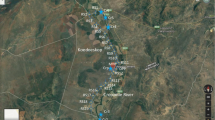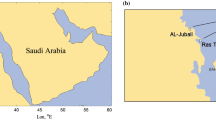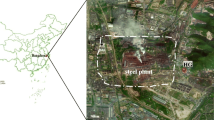Abstract
Harbour activities such as loading, unloading and transport of materials may be an important source of Atmospheric Particulate Matter (APM). Depending on the materials, the type of operation and the meteorological conditions, these activities may have an impact on the levels of APM around harbour areas. The aim of this work was to characterize the emissions of dust providing from operations associated with phosphorite handling in harbours. Phosphorite is a non-detrital sedimentary rock which contains high amounts of phosphate bearing minerals and is used for the production of phosphorous based fertilizers. When handled in harbours frequently cause visual and environment impacts due to its physical and chemical characteristics. The techniques Instrumental Neutron Activation Analysis and Particle Induced X-ray Emission were applied as sensitive analytical tools for the determination of heavy metals and rare earth elements in phosphorite and in the APM sampled in the harbour during the unloading operations. Results showed that manipulation of phosphorite during harbour operations resulted in high emissions of particles, principally from the coarse fraction. These emissions were enriched in rare earth elements and heavy metals and were very affected by the provenience of the phosphorite.
Similar content being viewed by others
Explore related subjects
Discover the latest articles, news and stories from top researchers in related subjects.Avoid common mistakes on your manuscript.
Introduction
Huge amounts of pulverulent raw material are managed in harbour areas and handled in a diversity of loading, transport and storage operations. Depending on the material, operation conditions and meteorology, important dust plumes of Air Particulate Matter (APM) can be generated and can have a significant impact at nearby urban areas [1]. For example, in the 80s, the unloading of bulk soybean in the Barcelona harbour caused large increases in the number of asthma patients treated in emergency departments [2]. Similar associations were obtained by Ballester et al. [3] in Valencia and Coruna, Spain. In 2006, in Sines harbour, health authorities stopped an operation of clinker unloading due to the high quantities of emitted dust [4].
In this study dust emissions from phosphorite handling in harbours were studied. Phosphorite is a non-detrital sedimentary rock which contains high amounts of phosphate bearing minerals. The phosphate content of phosphorite is at least 20% which is a large enrichment over the typical sedimentary rock content of less than 0.2% [5]. Phosphorite contains high concentration of heavy elements—U, Th, REE (rare earth elements), etc., along with environment polluting elements—Cd, As, Sb, V, Cr, Zn, Cu, Ni, etc., [6, 7]. The amounts of these hazardous elements vary widely not only among various phosphate rock sources but also even in the same deposit [8].
Experimental
Sampling strategy
A measurement campaign was carried out in a harbour to characterize the dust emitted during unloading operations of phosphorite. These operations consisted in a grab that unload the material from the ship to a hopper that introduces the material inside the trucks.
APM measurements were performed during seven sampling periods: the first period occurred in a Sunday, therefore no operations were made in the harbour; the three following sampling periods were performed during the handling of phosphorite providing from Syria; and the last three sampling periods were executed during the unloading of phosphorite with Morocco origin (Table 1).
Given that APM levels depend not only on the distance of the sampling point from the source emission but also on the direction of the wind, all measurements were carried out in two sampling points with the same distance to the emission source (47 m) (Fig. 1). The data presented in this work for each sampling period correspond to the average of both sampling points. This strategy enabled us (1) to minimize the influence of the wind direction, (2) to compare the different sampling periods and (3) to have minor or negligible interferences of particles emitted by other sources [9].
Sampling equipment
Sampling of particles was performed with two low volume Gent samplers which were equipped with a PM10 pre-impactor stage and with a Stacked Filter Unit (SFU). The SFU carried, in two different stages, two 47 mm Nuclepore polycarbonate filters. Air was sampled at a rate of 15–16 l min−1, which allowed the collection of particles with aerodynamic diameter (AD) between 2.5 and 10 μm in the first stage and particles with DA < 2.5 μm in the second stage [10].
Characterization of PM2.5 and PM2.5–10
The filter loads were measured by gravimetry in a controlled clean room (class 10,000). Nuclepore filters were weighted on a semi-micro balance. Filter mass before and after sampling was obtained as the average of three measurements, when observed variations were less than 5%.
Each sampled filter was divided in four parts. For chemical identification one quarter was analysed by Particle Induced X-ray Emission (PIXE) [11]—to determine Al, Br, Ca, Cl, Cr, Cu, Fe, K, Mn, Ni, P, Pb, S, Si, Ti, V and Zn and another quarter by k 0 based Instrumental Neutron Activation Analysis (k 0-INAA) [12, 13]—to measure As, Ce, Co, La, Na, Sb, Sc, Sm and U.
PIXE analysis was carried out at a Van de Graff accelerator, in vacuum and two X-ray spectra were taken for each of the samples; one with a 1.2 MeV proton beam and no absorber in front of the Si (Li) detector for low energy X-ray elements and another with a 2.4 MeV proton beam and a 250 μm Mylar® filter to detect elements with atomic number higher than 20. The beam area at the target was 20 mm2.
For k 0-INAA, the filter quarter was rolled up and put into a clean thin foil of aluminium and irradiated for 5 h at a thermal neutron flux of 1.03 × 1013 cm−2 s−1 in the Portuguese Research Reactor. After irradiation, the sample was removed from the aluminium foil and transferred to a polyethylene container. For each irradiated sample, two gamma spectra were measured with a hyperpure germanium detector: one spectra 3 days after the irradiation and the other one after 4 weeks. The k0-INAA method was used and 0.1% Au–Al discs were co-irradiated as comparators. Tests of reproducibility within the filters and between filters were taken, using parallel sampling with two similar sampling units and measuring the particle species by INAA. Results were reproducible to within 5–15%, providing strong support for the validity of the analytical techniques [14, 15]. The accuracy of analytical methods was evaluated with NIST filter standards, revealing results with an agreement of ±10% [16]. Blank Nuclepore filters were treated the same way as regular samples. All measured species were very homogeneously distributed; therefore concentrations were corrected by subtracting the filter blank contents.
Results and discussion
PM2.5 and PM2.5–10 mass concentration
Figure 2 shows that the high volume of materials handled in the harbour originated a significant emission of particles principally in the coarse fraction of PM10. During the discharge of phosphorite from Syria, PM10 levels of up to 330 μg m−3 were measured (PM2.5: 60 μg m−3 and PM2.5–10: 270 μg m−3).
Results showed that emissions providing from unloading operation depended on the characteristics of the discharged material. Significant differences were detected between the phosphorite provided from Syria and phosphorite with Morocco origin. In the latter one, PM10 levels of 139 μg m−3 were measured (PM2.5: 43 μg m−3 and PM2.5–10: 96 μg m−3).
PM2.5 and PM2.5–10 chemical characterization
The chemical composition of PM2.5 and PM2.5–10 sampled in the harbour is shown in Fig. 3.
The major elements (concentrations >1,000 ng m−3) measured in PM2.5 and PM2.5–10 sampled during phosphorite handling were Ca, P and Si. These results were expected as the characterization of handled phosphorite showed that Ca (30%), P (9.8%) and Si (2.5% for Syria phosphorite and 2.0% for Morocco phosphorite) were the dominant elements in this material. More details about phosphorite characterization was given by Silva et al. [17].
APM sampled during Sunday presented higher levels for Na (684 ng m−3) and S (584 ng m−3) in PM2.5 and for Na (2230 ng m−3) and Cl (1230 ng m−3) in PM2.5–10. These results reflected the natural (mainly sea spray) and anthropogenic local sources.
During phosphorite handling it was observed an increase of some element concentrations comparing with the measurements made in the harbour without operation.
Ratios harbour operation/Sunday higher than 10 were registered for the elements Ca, Cr, La, Mn, Ni, P, Pb, V and Zn. Ratios higher than 50 were determined for the elements Ca (measured in PM2.5 sampled during handling of Syria phosphorite), P (measured in PM2.5 sampled during unloading of both types of phosphorite and in PM2.5–10 collected when Syria phosphorite was operated) and Cr (measured in PM2.5–10 sampled during unloading of both types of phosphorite).
A ratio higher than 100 was obtained for P for both types of phosphorite in fine fraction.
Cu and U, in both fractions, and Ce, Co, Sb, Sc and Sm, in coarse fraction, were only measured during the handling operations. Some works have already demonstrated concern not only about the presence of these heavy metals (such as Cr, Cu, Ni, Pb, and Zn) and radioactive elements (like U) in phosphorite used to produce phosphate fertilizers [7, 18–20], but also about the implications that this fact has for the contamination of the air, soil, water and food chain [7].
Differences between the emissions provided from the handling of phosphorite from different origins were found. PM2.5 samples collected during the operation of phosphorite from Syria presented higher concentrations of Sm, Sc and U. Sabiha-Javied et al. [7] made a comparative study of phosphorite provide from 16 different countries (included Syria and Morocco) and concluded that the composition of them is significantly different. This fact can explain the differences found, in this study, for the two types of handled materials.
Conclusions
Results showed that phosphorite unloading in the harbour originated significant emission of particles principally in the coarse fraction. Emissions from these operations depended on the origin of the phosphorite. Significant differences were detected between PM2.5–10 mass concentration measured during the unloading of phosphorite provided from Syria and unloading of phosphorite with Morocco origin.
The high levels of PM2.5 and PM2.5–10 measured during the phosphorite handling resulted in higher concentrations of elements, some of them potential toxic such as Cr, Cu, Ni, Pb, Sb, U and V. It should be pointed out that these APM levels should be considered as emission levels and not as ambient levels given the short distances from the emission to the sampling point. However, the relevance of these element concentrations should be pointed out.
References
Moreno N, Alastuey A, Querol X, Artinano B, Guerra A, Luaces JA, Lorente A, Basora J (2002) Atmos Environ 41:6331–6343
Antó JM, Sunyer J, Rodriguez-Roisin R, Suarez-Cervera M, Vazquez L (1989) N Engl J Med 320:1097–1102
Ballester F, Soriano JB, Otero I, Rivera ML, Sunyer J, Merelles A, Verea H, Marin J, Anto JM (1999) Am J Epidemiol 149:315–322
Almeida SM (2006) Atmospheric emissions from the operation of unloading of clinker in the Port of Sines. Client CNE, ISQ, Portugal (in Portuguese)
Harvey B, Tracy RJ (1996) Petrology, 2nd edn. Freeman, Minnesota, pp 345–349
Sabiha-Javied, Waheed S, Siddique N, Tufail M, Chaudhry MM, Irfan N (2008) J Radioanal Nucl Chem 278:17–24
Sabiha-Javied, Mehmood T, Chaudhry MM, Tufail M, Irfan N (2009) Microchem J 91:94–99
Stocia L, Georgescu IL, Filip D, Bunus F (1997) J Radioanal Nucl Chem 216:161–163
Almeida SM, Silva AV, Freitas MC, Marques AM, Ramos CA, Silva AI, Pinheiro T (2011) J Radioanal Nucl Chem. doi:10.1007/s10967-011-1279-4
Maenhaut W (1992) The gent stacked filter unit (SFU) sampler for the collection of atmospheric aerosols in two size fractions: description and instructions for installation and use, IAEA CRP E4.10.08, Belgium
Johansson SAE, Campbell JL, Malmqvist KG (1995) Particle-induced X-ray emission spectrometry (PIXE). Wiley, New York
Cornelis R, Hoste J, Speecke A, Vandecasteele C, Versieck J, Gijbels R (1976) Activation analysis-part 2. In: West TS (ed) Physical chemistry, series two. Analytical chemistry-part I, vol 12. Butterworth, London, p 137
De Corte F (1987) The k 0-standardization method—a move to the optimization of neutron activation analysis. Agregé thesis, Gent University, Gent
Almeida SM, Reis MA, Freitas MC, Pio CA (2003) Nucl Instrum Methods Phys Res B 207:434–446
Almeida SM, Freitas MC, Reis MA, Pio CA (2003) J Radioanal Nucl Chem 257:609–613
Almeida SM, Freitas MC, Reis MA, Pio CA, Trancoso MA (2006) Nuclear instruments and methods in physics research A 564:752–760
Silva AV, Almeida SM, Freitas MC, Marques AM, Silva AI, Ramos CA, Pinheiro T, Garcia SM, Domingues G, Miranda AI (2011) Proceedings of the global conference on global warming, Lisbon, pp 209–217
Pantelica AI, Salagean MN, Georgescu II, Pincovschi ET (1997) J Radioanal Nucl Chem 216:261–264
Ogunleye PO, Mayaki MC, Amapu (2002) J Environ Radioact 62:39–48
Camelo LGL, Miguez SR, Marban L (1997) The Sci Total Environ 204:245–250
Acknowledgments
The authors gratefully acknowledge Fundação para a Ciência e Tecnologia (FCT) for funding S.M. Almeida by Ciencia 2007 programme and the project PTDC/AAC-AMB/098825/2008—PMfugitive—Mitigating the environmental and health impacts of particles from fugitive emissions.
Author information
Authors and Affiliations
Corresponding author
Rights and permissions
About this article
Cite this article
Silva, A.V., Almeida, S.M., Freitas, M.C. et al. INAA and PIXE characterization of heavy metals and rare earth elements emissions from phosphorite handling in harbours. J Radioanal Nucl Chem 294, 277–281 (2012). https://doi.org/10.1007/s10967-011-1524-x
Received:
Published:
Issue Date:
DOI: https://doi.org/10.1007/s10967-011-1524-x







